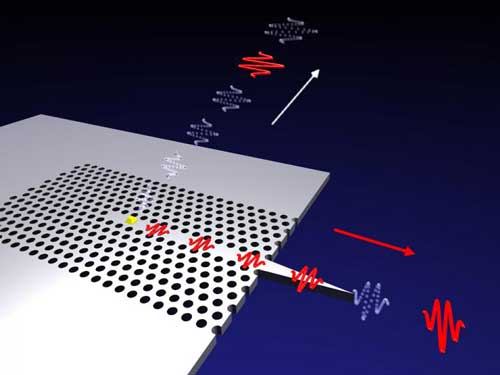Quantum Photonics: Nanoscale Light Manipulation for Quantum Tech
What is Quantum Photonics?
Quantum photonics is an interdisciplinary field that combines the principles of quantum mechanics and photonics to study and manipulate light at the single-photon level. It explores the generation, control, and detection of individual photons, as well as their interactions with matter at the nanoscale. Quantum photonics aims to harness the unique properties of photons for applications in quantum information processing, secure communications, and ultra-sensitive sensing.

Fundamentals of Quantum Photonics
Quantum photonics relies on several fundamental concepts and phenomena that distinguish it from classical optics:
Single-Photon Sources
A key requirement in quantum photonics is the ability to generate single photons on demand. Single-photon sources, such as quantum dots, color centers in diamond, and nonlinear optical processes, are used to emit individual photons with high purity and indistinguishability. These sources form the basis for quantum communication protocols and photonic quantum computing.
Quantum Entanglement
Quantum entanglement is a phenomenon where two or more photons become correlated in such a way that their properties are linked, regardless of the distance between them. Entangled photon pairs can be generated through processes like spontaneous parametric down-conversion (SPDC) or four-wave mixing (FWM). Entanglement is a crucial resource for quantum teleportation, quantum cryptography, and quantum computing.
Quantum Interference
Quantum interference occurs when two or more photons interact in a way that leads to the enhancement or suppression of their probability amplitudes. This phenomenon is exploited in quantum photonic devices, such as beam splitters and interferometers, to perform quantum logic operations and quantum measurements. Quantum interference is the foundation for photonic quantum computing and quantum metrology.
Quantum Photonic Devices and Materials
Quantum photonics relies on a variety of nanoscale devices and materials to control and manipulate single photons:
Photonic Crystals
Photonic crystals are periodic nanostructures that can confine and guide light at the nanoscale. They can be engineered to have a photonic bandgap, which prevents light of certain frequencies from propagating through the structure. Photonic crystals are used to create high-quality optical cavities, waveguides, and filters for quantum photonic circuits.
Quantum Dots
Quantum dots are nanoscale semiconductor structures that can confine electrons and holes in all three spatial dimensions. They exhibit discrete energy levels and can emit single photons when excited by an external source. Quantum dots are promising candidates for single-photon sources, quantum memories, and quantum sensors.
Nanophotonic Waveguides
Nanophotonic waveguides are structures that can guide and confine light at the nanoscale, enabling the efficient transmission of single photons. They can be fabricated using various materials, such as silicon, silicon nitride, or III-V semiconductors. Nanophotonic waveguides form the backbone of integrated quantum photonic circuits, allowing for the manipulation and routing of single photons on a chip.
Applications of Quantum Photonics
Quantum photonics has a wide range of potential applications in quantum information processing and sensing:
Quantum Computing
Photonic quantum computing leverages the properties of single photons to perform quantum logic operations. Photons are ideal candidates for quantum information processing due to their low decoherence, fast propagation, and ease of manipulation. Photonic quantum computers have the potential to solve certain computational problems much faster than classical computers, such as factoring large numbers and simulating complex quantum systems.
Quantum Communication
Quantum photonics enables secure quantum communication protocols based on the principles of quantum mechanics. Quantum key distribution (QKD) uses entangled photon pairs to establish a secret key between two parties, which can then be used to encrypt and decrypt messages. The security of QKD is guaranteed by the laws of quantum physics, making it virtually unbreakable by eavesdroppers.
Quantum Sensing and Metrology
Quantum photonics offers unprecedented sensitivity and precision in sensing and metrology applications. Single photons can be used to detect tiny changes in physical quantities, such as magnetic fields, electric fields, and temperature. Quantum-enhanced sensors, such as squeezed light sensors and entangled photon sensors, can surpass the classical limits of sensitivity and resolution.
Challenges and Future Perspectives
Despite the remarkable progress in quantum photonics, several challenges remain to be addressed. One of the main challenges is the scalability of quantum photonic systems. The integration of large numbers of single-photon sources, detectors, and quantum gates on a single chip is a significant hurdle. Additionally, the efficient generation and manipulation of entangled photon states in complex quantum circuits is a pressing issue.
Future research in quantum photonics will focus on the development of high-performance single-photon sources, detectors, and quantum gates. The integration of quantum photonic devices with other quantum technologies, such as superconducting qubits and trapped ions, will enable hybrid quantum systems with enhanced capabilities. Furthermore, the exploration of new materials and fabrication techniques will lead to the realization of scalable and robust quantum photonic platforms.
Further Reading
Nature Photonics, Integrated photonic quantum technologies
Nature Reviews Physics, The potential and global outlook of integrated photonics for quantum technologies
Applied Sciences, Quantum Information with Integrated Photonics
